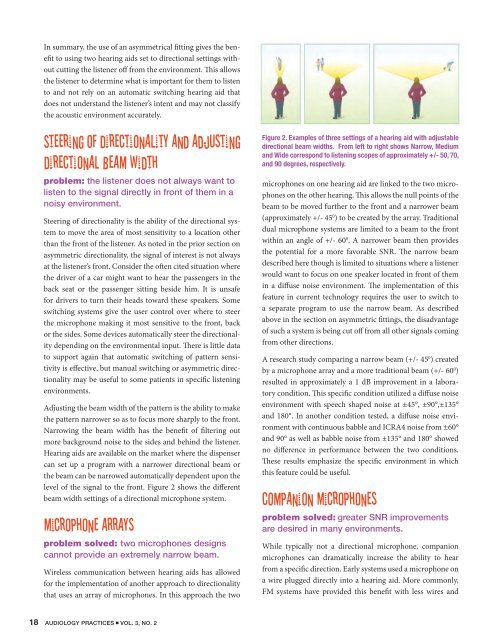IN THIS ISSUE - Academy of Dispensing Audiologists
IN THIS ISSUE - Academy of Dispensing Audiologists
IN THIS ISSUE - Academy of Dispensing Audiologists
Create successful ePaper yourself
Turn your PDF publications into a flip-book with our unique Google optimized e-Paper software.
In summary, the use <strong>of</strong> an asymmetrical fitting gives the benefit<br />
to using two hearing aids set to directional settings without<br />
cutting the listener <strong>of</strong>f from the environment. This allows<br />
the listener to determine what is important for them to listen<br />
to and not rely on an automatic switching hearing aid that<br />
does not understand the listener’s intent and may not classify<br />
the acoustic environment accurately.<br />
Steering <strong>of</strong> Directionality and Adjusting<br />
Directional Beam Width<br />
problem: the listener does not always want to<br />
listen to the signal directly in front <strong>of</strong> them in a<br />
noisy environment.<br />
Steering <strong>of</strong> directionality is the ability <strong>of</strong> the directional system<br />
to move the area <strong>of</strong> most sensitivity to a location other<br />
than the front <strong>of</strong> the listener. As noted in the prior section on<br />
asymmetric directionality, the signal <strong>of</strong> interest is not always<br />
at the listener’s front. Consider the <strong>of</strong>ten cited situation where<br />
the driver <strong>of</strong> a car might want to hear the passengers in the<br />
back seat or the passenger sitting beside him. It is unsafe<br />
for drivers to turn their heads toward these speakers. Some<br />
switching systems give the user control over where to steer<br />
the microphone making it most sensitive to the front, back<br />
or the sides. Some devices automatically steer the directionality<br />
depending on the environmental input. There is little data<br />
to support again that automatic switching <strong>of</strong> pattern sensitivity<br />
is effective, but manual switching or asymmetric directionality<br />
may be useful to some patients in specific listening<br />
environments.<br />
Adjusting the beam width <strong>of</strong> the pattern is the ability to make<br />
the pattern narrower so as to focus more sharply to the front.<br />
Narrowing the beam width has the benefit <strong>of</strong> filtering out<br />
more background noise to the sides and behind the listener.<br />
Hearing aids are available on the market where the dispenser<br />
can set up a program with a narrower directional beam or<br />
the beam can be narrowed automatically dependent upon the<br />
level <strong>of</strong> the signal to the front. Figure 2 shows the different<br />
beam width settings <strong>of</strong> a directional microphone system.<br />
Microphone Arrays<br />
problem solved: two microphones designs<br />
cannot provide an extremely narrow beam.<br />
Wireless communication between hearing aids has allowed<br />
for the implementation <strong>of</strong> another approach to directionality<br />
that uses an array <strong>of</strong> microphones. In this approach the two<br />
18 AUDIOLOGY PRACTICES n VOL. 3, NO. 2<br />
Figure 2. Examples <strong>of</strong> three settings <strong>of</strong> a hearing aid with adjustable<br />
directional beam widths. From left to right shows Narrow, Medium<br />
and Wide correspond to listening scopes <strong>of</strong> approximately +/- 50, 70,<br />
and 90 degrees, respectively.<br />
microphones on one hearing aid are linked to the two microphones<br />
on the other hearing. This allows the null points <strong>of</strong> the<br />
beam to be moved further to the front and a narrower beam<br />
(approximately +/- 45 0 ) to be created by the array. Traditional<br />
dual microphone systems are limited to a beam to the front<br />
within an angle <strong>of</strong> +/- 60 0 . A narrower beam then provides<br />
the potential for a more favorable SNR. The narrow beam<br />
described here though is limited to situations where a listener<br />
would want to focus on one speaker located in front <strong>of</strong> them<br />
in a diffuse noise environment. The implementation <strong>of</strong> this<br />
feature in current technology requires the user to switch to<br />
a separate program to use the narrow beam. As described<br />
above in the section on asymmetric fittings, the disadvantage<br />
<strong>of</strong> such a system is being cut <strong>of</strong>f from all other signals coming<br />
from other directions.<br />
A research study comparing a narrow beam (+/- 45 0 ) created<br />
by a microphone array and a more traditional beam (+/- 60 0 )<br />
resulted in approximately a 1 dB improvement in a laboratory<br />
condition. This specific condition utilized a diffuse noise<br />
environment with speech shaped noise at ±45°, ±90°,±135°<br />
and 180°. In another condition tested, a diffuse noise environment<br />
with continuous babble and ICRA4 noise from ±60°<br />
and 90° as well as babble noise from ±135° and 180° showed<br />
no difference in performance between the two conditions.<br />
These results emphasize the specific environment in which<br />
this feature could be useful.<br />
Companion Microphones<br />
problem solved: greater SNR improvements<br />
are desired in many environments.<br />
While typically not a directional microphone, companion<br />
microphones can dramatically increase the ability to hear<br />
from a specific direction. Early systems used a microphone on<br />
a wire plugged directly into a hearing aid. More commonly,<br />
FM systems have provided this benefit with less wires and










